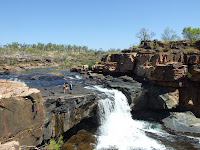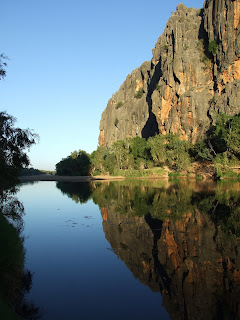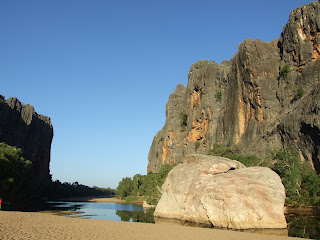A Red-backed Fairy Wren
We have made it to Western Australia, via Keep River National Park and the Adelaide River, with the stunning Stokes Range as a backdrop along the way.
Ranges of red snaked along our travels, with bare-branched Boab trees standing on the sweeping foothills, like a hallelujah chorus, arms upraised. The ranges were like ancient castle walls, and you could imagine the sounds of battles and arrows shooting down from the castle parapets, which were the darker rock lines that ran across the tops of the range. At Timber Creek we bought the world’s most expensive lettuce, $6.90, for a small iceberg. Keep River NP was a mini Bungle Bungles, with palm-lined gorges. Crossing the border, we had to go through quarantine, handing over all fruit and vegetables (including what was left of the world’s most expensive lettuce), honey and nuts. They even searched the car, but let us keep Russ!
We stayed at Kununurra for a few days, in the “French quarter”. Well we opted to stay down with the fruit picking backpackers, as they were better company than some others. We were camped next to about 6 small dome tents that appeared to be mostly French backpackers. There was a larger group across the way that had a Danish flag flying amongst their 12 or more tents, arrayed around some old car seats and a rusty fridge, possibly plugged into a tree (an electric Boab?). Kununurra reminded Russ of Griffith, with its flat landscape and irrigation channels. We took a drive out to some of the farms, and apart from the 33 degree heat in August; you could imagine you were in the MIA. We visited the Sandalwood farm, where they grow both Australian and Indian sandalwood. These trees have to be grown in a companion planting arrangement with three other species, of both tree and vine. The Australian trees take 20 years to be productive, whilst the Indian trees take 15 years. The Indian variety is still in the pre-market development phase. Did you know that sandalwood was one of Western Australia’s major export industries in the 19th century?
After restocking and catching up on washing, we headed for Purnululu NP (aka the Bungle Bungles), a 4 hour drive south-west, with the last 2 hours over some pretty rugged dirt through Mabel Downs Station. 18 water crossings to get to the National Park and this is the dry season! “Wow”, is probably the best descriptive word right now for this sublimely magical place. We spent 4 nights there, exploring as much as possible and going on some wondrous walks. Falling asleep at night, with dingoes howling near by. You had a sense of an ancient land, filled with dream time stories. We feel very privileged to have been allowed to walk amongst those colourful, tiger-striped, magnificent domes.
We are now at the half way mark of our travels and have made some observations.
Firstly, we are not very good at this travelling thing! We get up after everyone else has packed. We try to have showers when the cleaners are in there, and they are closed. We are always the last to leave the camp site. We arrive late into our next site, and we don’t like camping cheek by jowl with others. Oh well.
We have been documenting aspects of the species we like to call Nomadis greyess. They are a migratory species, leaving the cold southern climes in winter for the warmer north. They appear to be escaping both the cold and their occupation as babysitters for their grandchildren. We have observed that they are grey in plumage, tend to travel in pairs, are very gregarious within their species and tend to show herding behaviour around certain spots. These include fish cleaning huts, free road side camping spots and stalls at the markets selling products for feet (more on this later). They are thigmotaxic, that is, they seem to like to camp so close to each other as to be touching their neighbours vans.
We have observed some sub-species within the general Nomadis genus. There are the Nomadis greyess urbansis, who appear to migrate to the same spots, year after year, towing large vans or Winnebago’s, kept spotlessly clean. This sub species are very territorial and house proud, like bower birds arranging and rearranging their trinkets, and constantly cleaning and preening. They scowl when children dare to have fun at the camp pool and will often act as camp majors, telling the children the rules. Whilst in this state they can be heard making tut tutting sounds.
The second subspecies are the Nomadis greyess adventurous. They often travel in pairs, but some times can be seen as solitary migrators. They tend to travel in converted utes, with a minimum of paraphernalia. They can be found all over Australia, often on dirt tracks and in the bush. They are an intrepid species.
Our third observation is ‘feet’. After 4 months of living in thongs, our feet have taken on some rather nasty habits. They are tanned, constantly dirty, with very rough skin and heel cracks. DISGUSTING! Why weren’t we warned. We are carrying a mountain of pumice stones and heel balm preparations. And like other travellers, we are drawn to market stalls selling “foot care” products. A related observation relates to the poor quality of thongs available in this country for serious bushwalking. Ellen and Russ are currently competing to see who can burn-out the most pairs of thongs. Ellen currently wins with 5, Russ 4. (Jenny and Maeve just aren’t really trying and keep cheating by wearing sensible walking boots.)
Next, caravan park washing machines can cost from $3 to $5 a load, they wet your clothes, the clothes come out smelling slightly better, but don’t look any cleaner. There is also a national sport (usually amongst the gals) to race and occupy said costly-but-next-to-useless machines as early as possible in the day (ie well before we open our eyes – see above). This then provokes a tense queuing behaviour where days can be spent waiting your turn.
Lastly, despite all the warnings from friends and seasoned travellers, we failed to heed their advice and have packed far too many clothes!
It’s 15 August now and we’re back in Kununurra, to stock up for our next exciting episo de where we battle the Gibb River track on our way to Broome, Cape Leveque etc. We hope to make it to Mitchell Plateau and possibly Kalumburu up on the north coast as well, depending on the road conditions. Shaken but not stirred. Let’s see how we go, and we’ll keep you posted when back on-line. |





















































